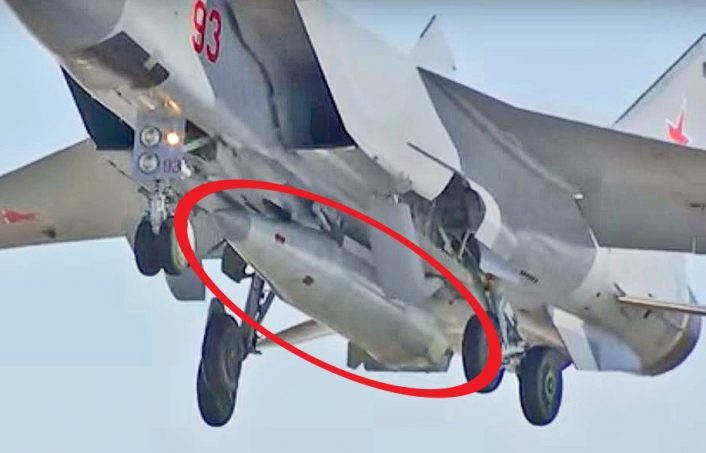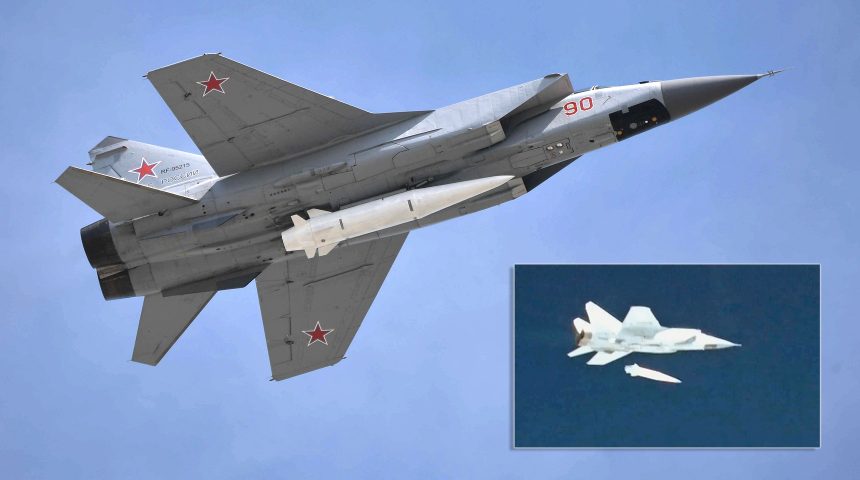According to the Russian MOD, the Kinzhal hypersonic missiles to destroy a weapons storage site western Ukraine.
The Russian Ministry of Defense has announced Russian forces made use of the Kinzhal hypersonic aero-ballistic missiles to destroy a large underground warehouse of missiles and aviation ammunition of Ukrainian troops in the village of Delyatyn, Ivano-Frankivsk region, in Ukraine’s western part, on Mar. 18, 2022.
No additional details about the first reported use of the air-launched Kinzhal (Dagger) hypersonic missile in the war in Ukraine have been released so far, but (if confirmed) for sure the use of this kind of weapon appears to be rather symbolic: it’s probably a message to Ukraine and NATO that Russia has options to escalate the conflict. In fact, the hypersonic ballistic missile is dual capable: it can carry a nuclear (100-500 kT) or HE fragmentation warhead.

Kinzhal is basically an air-launched Iskander-M SRBM (short-range ballistic missile) that uses a MiG-31 Foxhound or Tu-22M3 Backfire assets as an air-breathing first stage to increase its range: in fact, it is actually not a “hypersonic weapon” in the sense that it is an air-breathing missile based on scramjet technology and, as a ballistic missile, it flies at hypersonic speed with a reported cruise missile-like flat flight profile.
All the details about the missile can be found in the article we published here at The Aviationist in 2018, when the missile the Kinzhal was first test-fired:
Kinzhal is claimed to be a strategic air-to-surface strike missile. The missile is claimed to have maneuverable flight characteristics not typically seen in hypersonic, solid fuel missiles. Observers of Russian missile programs have voiced skepticism about Russia’ performance claims however. According to Russians and reference sources the Kinzhal missile has a top speed of Mach 10 and maintains some ability to maneuver throughout its performance envelope including at hypersonic speed. If accurate, these capabilities could make the Kinzhal difficult to intercept by anti-missile systems. The missile is reported to have a range of 1,200 miles (approximately 2,000 kilometers). This, added to the reported 1,860-mile unrefueled range of the MiG-31BM long range, supersonic interceptor, gives the Kinzhal potentially intercontinental strike capability. The missile is also reported to be nuclear-capable and able to hit ground as well as naval targets.
[…]
Hypersonic cruise missiles have the capability to defeat or degrade the effectiveness of most current surveillance and anti-missile systems because of their speed (and, in the case of this new Kinzhal, claimed capability to maneuver). The choice of the aging MiG-31, that would probably launch the Kinzhal from +60,000 feet at supersonic speed, is aimed at giving the tactical ballistic missile much more reach than it would have if launched from the ground: indeed, during the Cold War, the long-range high-altitude interceptor was supposed to be used as launch platform for anti-satellite weapons that could destroy targets in near space. Capable to carry up to four long-range R-33 missiles and four short-range R-77 missiles, not only was the MiG-31BM expected to carry a weapon able to shoot down space satellites; it was also intended to be used as a “cruise missile interceptor”: the Foxhounds have been involved in tests to intercept cruise missiles, previously Kh-55 and more recently Kh-101, for years.
While the Kinzhal appears to be an air-to-ground missile the pairing of this nuclear capable hypersonic missile recalls the much older AIR-2 Genie nuclear armed air-to-air missile with a 1.5 kiloton warhead. The AIR-2 Genie and earlier versions of the same missile were deployed by the U.S. Air Force from 1957-1962.
Along with the symbolic message the use of such missile would send to Ukraine and NATO (once again, provided it is confirmed), there are also chances the Kinzhal was used as part of a sort of on-field test: for instance, the Syrian Air War was for Russia a sort of testbed to test their most advanced hardware, including those still under development: in February 2018, two Su-57s were deployed to Khemimim airbase near Latakia for the first time; on Sept. 13, 2017, the Russian Air Force deployed some of its MiG-29SMT multirole combat aircraft to Syria. Previously, in February 2016, it was the turn of the still-in-development Tu-214R spyplane to exploit the air war in Syria to test its sensor packages.
Meanwhile some videos allegedly showing the Kinzhal at work have started circulating online. Beware, these are not been verified yet:
This appears to be footage taken by an Orlan-10 UAV of a Russian Kinzhal air-launched ballistic missile strike on a missile warehouse in Delyatyn, Ivano-Frankivsk Oblast previously announced by the Russian MoD. The Kinzhal was launched by a MiG-31K.https://t.co/0oYGQRc1r6 pic.twitter.com/3US5PakoBy
— Rob Lee (@RALee85) March 19, 2022
Allegedly a clip showing the Russian Kh-47M “Kinzhal” heading towards a UKR underground bunker in east Ukraine
Not like what the western “experts” said this is NOT an air launched ballistic missile with a ballistic trajectory@200_zoka @WithinSyriaBlog pic.twitter.com/riW1jIvrAN
— W@EL (@WaelAllHussaini) March 19, 2022









